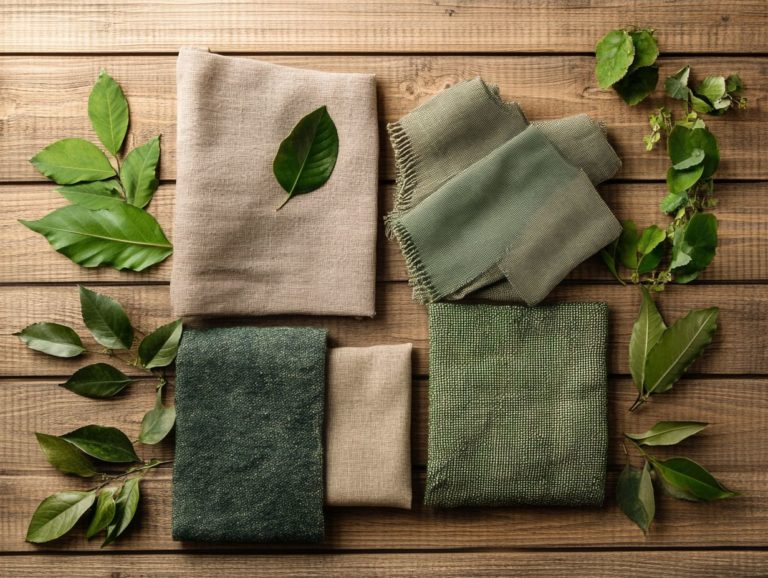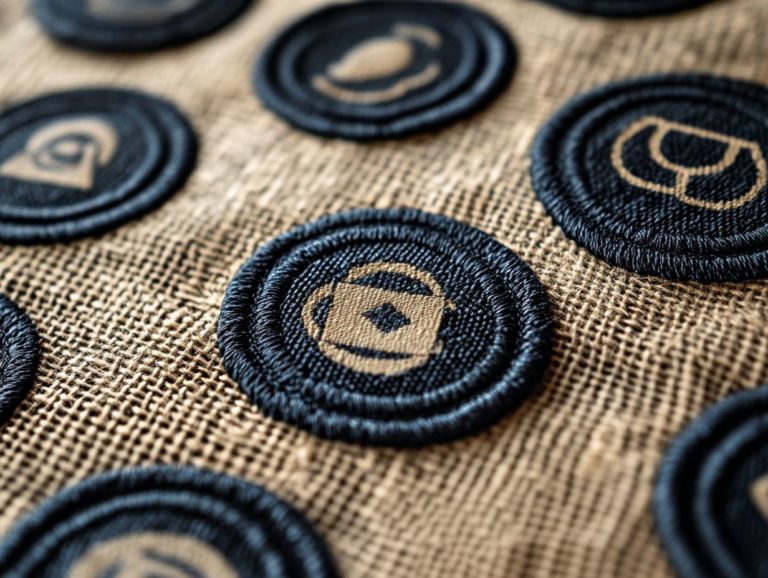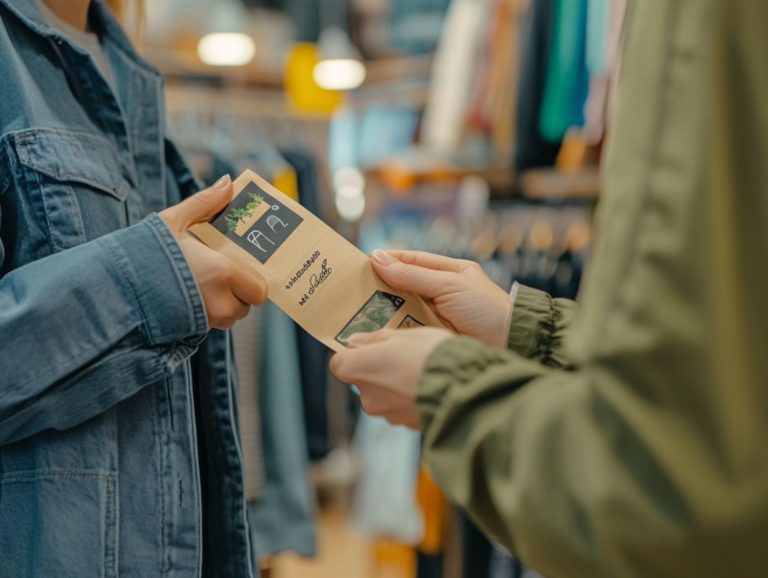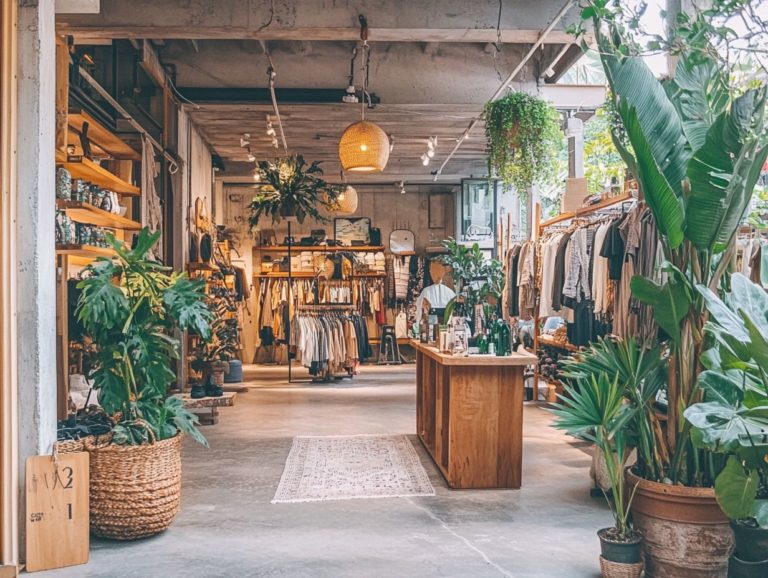The Importance of Sustainable Fashion Advocacy
Fast fashion has undeniably reshaped the clothing industry, yet it comes at a considerable environmental price. This article reveals the dire consequences of fast fashion on our planet and underscores the pressing need for support for sustainable fashion.
You’ll discover why embracing sustainable practices is essential, along with practical ways you can contribute to making a difference. The article also highlights successful examples of advocacy that have inspired genuine change.
Together, you can envision a future for the fashion industry that harmonizes style with sustainability.
Contents
- Key Takeaways:
- The Impact of Fast Fashion on the Environment
- The Need for Sustainable Fashion Advocacy
- How to Advocate for Sustainable Fashion
- The Role of Consumers in Sustainable Fashion
- Examples of Successful Sustainable Fashion Advocacy
- The Future of Sustainable Fashion
- Frequently Asked Questions
- What is the significance of sustainable fashion advocacy?
- Why is it important for the fashion industry to embrace sustainability?
- How does sustainable fashion advocacy benefit the environment?
- What role do consumers play in sustainable fashion advocacy?
- How does sustainable fashion advocacy promote social responsibility?
- What can individuals do to support sustainable fashion advocacy?
Key Takeaways:

- Fast fashion has a significant negative impact on the environment, contributing to pollution, waste, and resource depletion.
- Sustainable fashion advocacy is crucial to promote environmental and social responsibility in the fashion industry.
- Consumers have the power to drive change by making conscious and ethical purchasing decisions and demanding transparency and accountability from fashion brands.
The Impact of Fast Fashion on the Environment
The impact of fast fashion on the environment is both profound and multifaceted, leading to significant degradation through excessive textile consumption and waste. This industry emphasizes speed and cost, often at the expense of sustainability.
It fosters a throwaway culture that overlooks the long-term ecological consequences of textile production and waste disposal. The lessons of the COVID-19 pandemic have underscored that these practices not only jeopardize biodiversity but also erode the ethical standards essential for a sustainable future.
Environmental Consequences of Fast Fashion
Fast fashion has a profound impact on the environment, leading to pollution and an overwhelming amount of waste that poses serious risks to our ecosystems. The relentless churn of low-cost garments results in staggering textile waste piling up in landfills, where synthetic fibers can take decades, if not centuries, to break down.
The dyeing processes used to create those vibrant pieces often introduce hazardous chemicals into local water sources, harming aquatic life and the communities that depend on clean water. The fast fashion industry significantly contributes to carbon emissions, with rapid production cycles and global shipping adding to climate change.
Tackling these urgent issues is essential for paving the way toward a more sustainable future.
The Need for Sustainable Fashion Advocacy
Now, more than ever, we need your voice in sustainable fashion advocacy. The necessity for sustainable fashion advocacy has grown as more people grasp the adverse effects of fast fashion on our environment and society.
Embarking on this advocacy journey underscores the significance of ethical practices and conscientious consumer behavior. This movement enables you to participate in grassroots organizing and awareness campaigns that champion sustainable alternatives.
The future of fashion hinges on your collective effort to embrace practices that honor both people and the planet.
Why Sustainable Fashion is Important
Sustainable fashion holds significant importance as it champions ethical practices that mitigate environmental impact while uplifting artisan livelihoods and ensuring fair wages for workers. By prioritizing fair labor practices, sustainable fashion reflects a commitment not only to the planet but also to the talented individuals behind these creations.
This movement nurtures a sense of community, enabling you to contribute to local economies and help artisans sustain their craft. It plays a pivotal role in preserving cultural heritage, allowing traditional techniques and designs to thrive in a global marketplace.
As more brands acknowledge their responsibility toward social equity, the intersection of sustainability and social responsibility becomes ever more essential. This paves the way for a fashion industry that is both equitable and conscientious.
What can you do today to support sustainable fashion?
How to Advocate for Sustainable Fashion

Advocating for sustainable fashion requires a varied approach that truly engages you as a consumer, promotes ethical practices, and elevates awareness about the environmental impacts of fast fashion.
It s about inspiring you to make informed choices and encouraging a shift towards more responsible consumption.
Ways to Make a Difference
You have a myriad of opportunities to make a significant impact in the realm of sustainable fashion, whether that means participating in community events or embracing mindful shopping.
One compelling way to do this is by organizing clothing swaps in your local community. This not only lets you refresh your wardrobe without falling prey to the wasteful cycle of fast fashion, but also creates a vibrant space for connection among participants.
Engaging in these activities fosters a sense of camaraderie while significantly reducing the environmental toll associated with producing new garments.
Supporting social enterprises that prioritize ethical production methods can send powerful ripples through the industry. By choosing to purchase from brands committed to sustainability, you contribute meaningfully to a more responsible fashion landscape, especially by understanding the role of upcycling in sustainable fashion.
Getting involved in grassroots organizing helps advocate for policy changes and raises awareness about textile waste, amplifying the call for a shift toward sustainable fashion practices and inspiring others to join the movement.
The Role of Consumers in Sustainable Fashion
Consumers hold a crucial position in the realm of sustainable fashion, as their behaviors and choices wield considerable influence over industry standards and practices. This impact is especially pronounced in a landscape dominated by the relentless advance of fast fashion.
You can steer the industry with your choices! Your decisions shape a future that prioritizes sustainability.
How Consumers Can Drive Change
You have the power to drive change in sustainable fashion by actively supporting ethical practices and local communities, making informed choices that challenge the fast fashion norms.
By researching the companies behind your purchases, you can identify brands that prioritize fair labor practices and eco-friendly sourcing. Seeking out clothing made from sustainable materials not only reduces your environmental impact but also sets a benchmark for quality and longevity.
Engaging in local initiatives like clothing swaps and upcycling workshops turning old clothes into new products helps foster a sense of community and reinforces the importance of sustainability among your peers.
Each small step you take contributes to a collective movement, proving that your informed consumer decisions can create a ripple effect that benefits both the planet and society as a whole.
Examples of Successful Sustainable Fashion Advocacy
Examples of successful sustainable fashion advocacy showcase the remarkable impact of collective action. They highlight how organizations and movements are effectively working to counter the harmful effects of fast fashion, demonstrating that together, significant change is not only possible but achievable.
Real-Life Cases and Their Impact

Real-life cases of sustainable fashion advocacy clearly demonstrate the profound impacts on both the environment and local communities, highlighting the power of grassroots organizing.
Take, for example, the Fashion Revolution movement; it’s a well-documented initiative that has successfully raised awareness about ethical labor practices while enabling you, the consumer, to understand why sustainable fashion matters for future generations and make informed choices.
Then there s the emergence of upcycled fashion brands, which not only tackle waste but also spark creativity and innovation within the industry. These initiatives foster collaborations between local artisans and global labels, driving economic growth in underserved areas.
Such successful models emphasize the significance of transparency, allowing you to understand the origins of your garments and inspiring industry leaders to embrace more sustainable practices across the board.
Get involved in sustainable fashion today your choices matter!
The Future of Sustainable Fashion
The future of sustainable fashion is closely related to the shifting dynamics of consumer behavior, the commitment to ethical practices, and innovative solutions emerging to tackle the industry’s environmental impact.
As you navigate this evolving landscape, your choices and awareness play a pivotal role in shaping a more sustainable fashion ecosystem.
Predictions and Goals for the Industry
Predictions for the sustainable fashion industry indicate that we can expect increased consumer awareness and a significant shift toward more ethical practices, as advocacy journeys continue to gain momentum.
This evolving landscape points to a collective push aimed at achieving specific goals, such as dramatically reducing waste through innovative recycling methods, promoting fair wages for garment workers, and enhancing transparency in supply chains.
As you become more informed about the environmental impact of your choices, brands are likely to respond by incorporating sustainable materials and ethical sourcing into their offerings.
Organizations dedicated to sustainability will ramp up their efforts to educate the public, fostering a more responsible mindset among consumers.
This movement seeks to create a fashion ecosystem that balances responsibility with style and quality, ensuring that you can look good while feeling good about your choices.
Frequently Asked Questions
What is the significance of sustainable fashion advocacy?
Sustainable fashion advocacy is crucial in promoting environmentally friendly and socially responsible practices within the fashion industry. It sparks awareness about the negative impacts of fast fashion and encourages individuals and fashion brands to make sustainable choices.
Why is it important for the fashion industry to embrace sustainability?

The fashion industry is one of the biggest contributors to environmental degradation and social issues, such as labor exploitation. Embracing sustainability is essential to minimize these negative impacts and create a more ethical and environmentally friendly industry.
How does sustainable fashion advocacy benefit the environment?
Sustainable fashion advocacy promotes the use of eco-friendly materials, reduces waste and pollution, and encourages responsible production and consumption. These efforts help preserve natural resources and reduce the carbon footprint of the fashion industry.
What role do consumers play in sustainable fashion advocacy?
Consumers have the power to drive change in the fashion industry through their purchasing decisions. By choosing to support sustainable and ethical fashion brands, consumers send a strong message to the industry that sustainability matters.
Sustainable fashion advocacy raises awareness about labor exploitation and promotes fair working conditions for garment workers. By supporting ethical and transparent fashion brands, consumers can help improve the lives of those who make our clothes.
What can individuals do to support sustainable fashion advocacy?
- Buy from ethical and sustainable brands.
- Reduce personal consumption.
- Advocate for policy changes promoting sustainability in the fashion industry.
Now is the time to act for a better future! Your choices can make a significant impact.






